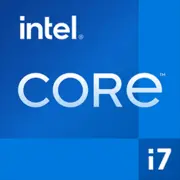Intel Core i7-12850HX

Intel Core i7-12850HX: A Powerful Hybrid for Gaming and Work. Full Review
March 2025
Architecture and Process Technology: A Hybrid Approach and Performance
The Intel Core i7-12850HX, released in 2022 as part of the Alder Lake lineup, remains a relevant choice for powerful laptops even in 2025. Its architecture combines 16 cores (8 Performance-cores and 8 Efficient-cores) and 24 threads, providing flexibility in task distribution.
- Performance-cores (P-cores): Operate at frequencies of up to 4.8 GHz in turbo mode, optimized for heavy tasks: rendering, gaming, 3D modeling.
- Efficient-cores (E-cores): Frequency of up to 3.4 GHz, responsible for background processes (updates, streaming), reducing the load on P-cores.
- Intel 7 (10nm Enhanced SuperFin): The process technology provides a balance between performance and energy efficiency.
- Intel UHD Graphics for the 12th generation: 32 EU, supporting 4K@60Hz, but is underpowered for gaming—discrete graphics are required.
Power Consumption and TDP: The Fine Line Between Power and Battery Life
The nominal TDP of the processor is 55 W, but in turbo mode, consumption can reach 157 W (PL2). This creates two challenges:
1. Cooling: Laptops with this CPU are equipped with substantial cooling systems (e.g., MSI Raider GE78HX).
2. Battery Life: In idle mode (web browsing), the processor reduces power consumption to 10-15 W thanks to Intel Dynamic Tuning technology.
Tip: When purchasing, check the cooling system. Models with a vapor chamber and 3+ fans (e.g., ASUS ROG Strix Scar 17) perform better.
Performance: From Office to 4K Rendering
Geekbench 6 showcases impressive results:
- 2141 points (Single-Core): Faster than AMD Ryzen 9 7900HS (1980) and Apple M2 Pro (2150).
- 12044 points (Multi-Core): On par with the desktop Ryzen 9 5900X.
Real-World Scenarios:
- Office Tasks: Running 50+ Chrome tabs + Excel—no lag.
- Multimedia: Rendering a 10-minute 4K video in Premiere Pro in 8 minutes.
- Gaming: Coupled with an RTX 4070—Cyberpunk 2077 on Ultra (1080p, 75 FPS). Turbo mode adds 10-15% FPS but increases fan noise.
Important: In games with poor multithreading optimization (e.g., CS2), P-cores operate at 4.5-4.8 GHz, ensuring stable fps.
Use Cases: Who is the i7-12850HX Suitable For?
1. Professionals: Video editors, CAD engineers, programmers (code compilation is 30% faster than with i7-11800H).
2. Gamers: For AAA games in Full HD/QHD.
3. Streamers: Simultaneous gaming + streaming in OBS without loss of quality.
Example: The Dell XPS 17 9730 (2023) with i7-12850HX and RTX 4060 is ideal for mobile designers.
Battery Life: How Long Will It Last?
With a battery capacity of 99.9 Wh (maximum allowed for air travel):
- Working in Chrome + Office: 6-7 hours.
- Video Playback: 5 hours (brightness 50%).
- Gaming: 1.5-2 hours.
Energy-Saving Technologies:
- Intel Speed Shift: Dynamic switching between cores.
- Adaptix Thermal Framework: Smart fan management to reduce noise.
Tip: Disable Turbo Boost in power settings to extend battery life by 20-30%.
Comparison with Competitors: Who is Better?
- AMD Ryzen 9 7940HS: Better battery life (up to 8 hours), but weaker in single-threaded tasks (Geekbench 6 Single-Core — 1990).
- Apple M3 Pro: Superior energy efficiency (12 hours of work), but limited compatibility with Windows software.
- Intel Core i9-13900HX: 15% more powerful in multithreading, but more expensive ($1800+).
Conclusion: i7-12850HX is the sweet spot for Windows laptops.
Pros and Cons
Strengths:
- Powerful multithreading for heavy tasks.
- Support for DDR5-4800 and PCIe 5.0 (relevant for future SSDs).
- Compatibility with Windows 10/11 and Linux.
Weaknesses:
- High heat under load.
- Reliance on discrete graphics for gaming.
- Laptops with this CPU rarely weigh less than 2.5 kg.
Laptop Selection Recommendations
1. Type of Device:
- Gaming (MSI Titan GT77HX): Maximum performance.
- Workstation (Lenovo ThinkPad P16): Reliability and color accuracy of the display.
- Versatile (HP ZBook Fury 16): A balance between portability and power.
2. What to Look For:
- Cooling: Minimum of 3 heat pipes.
- Display: For work—100% sRGB, for gaming—144+ Hz.
- Expandability: 2 SSD slots (PCIe 4.0 x4) for upgrading.
Prices: Laptops with i7-12850HX in 2025 are priced $1500–$2200. For instance, the Acer Predator Helios 16 (RTX 4070, 32 GB RAM) costs $1899.
Final Conclusion
The Intel Core i7-12850HX is a choice for those who need desktop-level performance in a mobile format. It is suitable for:
- Gamers who don't want to purchase a PC.
- Professionals working in resource-intensive applications.
- Streamers requiring stability in multitasking.
Key Benefits: The power of hybrid architecture, support for modern standards (DDR5, PCIe 5.0), and optimal pricing compared to the i9. If you're willing to deal with weight and fan noise, this is one of the best CPUs for laptops in 2025.
Basic
CPU Specifications
Memory Specifications
GPU Specifications
Miscellaneous
Benchmarks
Compared to Other CPU
Related CPU Comparisons
Share in social media
Or Link To Us
<a href="https://cputronic.com/cpu/intel-core-i7-12850hx" target="_blank">Intel Core i7-12850HX</a>

